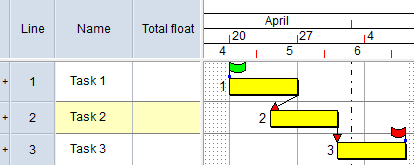'Negative float' quality metric
Use the 'negative float' metric to check the proportion of tasks with no negative float. Tasks should not have negative float. A high proportion of tasks with negative float can indicate an artificially accelerated or constrained schedule and that it will not be possible to complete a schedule by the current completion dates.
With the pass and fail boundaries set to 100.00%, this metric meets the requirements of CIOB stress test 7 (Negative float) and DCMA test 7 (Negative float).
In the following illustration, the conflicting constraints on Start On constraint on Task 1 and the Finish On constraint on Task 3 mean that there is not enough time for all three tasks to be completed:

Following a reschedule, these conflicting constraints cause Task 1 to have negative float, which represents time that must be caught up. A task with negative float is said to be super-critical:

After the reschedule the first task has negative float, which represents time that must be caught up. Note that in this example, all three tasks become critical. A task with negative float is said to be super-critical.
You can change the impact that this metric has on the weighted total result of a quality check by entering a factor by which the quality metric should be multiplied in the Weighting field. For the weighting to have any effect, a quality check must have more than one quality metric.
Pass and fail criteria
| Pass or fail? | Criteria |
|---|---|
| Pass |
A project passes this metric if the percentage of tasks that do not have negative float is greater than or equal to the pass boundary percentage.
For example, if the pass boundary was set to 100.00%, a project would pass this metric if 100.00% of tasks did not have negative float. |
| Fail |
A project fails this metric if the percentage of tasks that do not have negative float is less than the fail boundary percentage.
For example, if the fail boundary was set to 100.00%, a project would fail this metric if less than 100.00% of tasks did not have negative float. |
| Neither pass nor fail | If the percentage of tasks that do not have negative float falls between the pass and fail boundary percentages, the result is neither a pass nor a fail, but somewhere in between. |
Suggested settings to meet the requirements of CIOB stress test 7 (Negative float) and DCMA test 7 (Negative float)
- Pass boundary: 100.00%. A project will pass this metric if no tasks have negative float.
- Fail boundary: 100.00%. A project will fail this metric if any tasks have negative float.
The following table shows whether some example projects would pass or fail this metric using these settings:
| Percentage of tasks with no negative float | Pass or fail? |
|---|---|
| 0.00% | Fail |
| 50.00% | Fail |
| 99.99% | Fail |
| 100.00% | Pass |
Does the metric force a project to be rescheduled?
Yes. If you include this metric in a quality check, the charts and summary groups that are included in the scope of the quality check are rescheduled automatically when you execute the quality check.
Suggested actions if a project fails this metric
If a project fails this metric, select the metric in the Quality Check Results dialog and click Show Failing Tasks to view the tasks that have failed the metric.
Examine the failing tasks for any conflicting constraints that result in there being insufficient time for a task to be completed, and remove one or more of the constraints.
Introduction to schedule quality checking